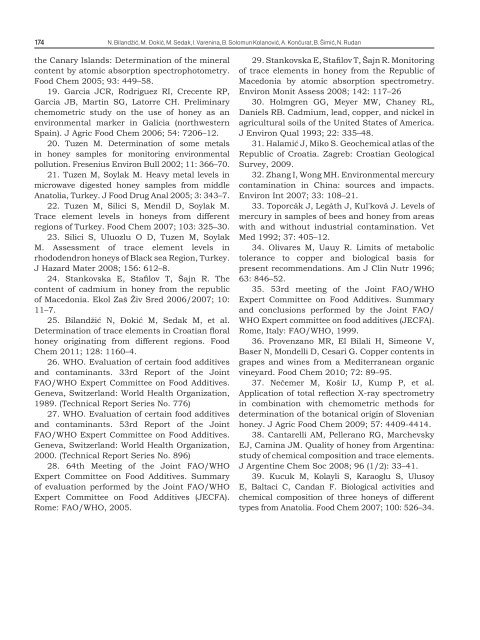SLOVENIAN VETERINARY RESEARCH
SLOVENIAN VETERINARY RESEARCH
SLOVENIAN VETERINARY RESEARCH
You also want an ePaper? Increase the reach of your titles
YUMPU automatically turns print PDFs into web optimized ePapers that Google loves.
174<br />
N. Bilandžić, M. Ðokić, M. Sedak, I. Varenina, B. Solomun Kolanović, A. Končurat, B. Šimić, N. Rudan<br />
the Canary Islands: Determination of the mineral<br />
content by atomic absorption spectrophotometry.<br />
Food Chem 2005; 93: 449–58.<br />
19. Garcia JCR, Rodriguez RI, Crecente RP,<br />
Garcia JB, Martin SG, Latorre CH. Preliminary<br />
chemometric study on the use of honey as an<br />
environmental marker in Galicia (northwestern<br />
Spain). J Agric Food Chem 2006; 54: 7206–12.<br />
20. Tuzen M. Determination of some metals<br />
in honey samples for monitoring environmental<br />
pollution. Fresenius Environ Bull 2002; 11: 366–70.<br />
21. Tuzen M, Soylak M. Heavy metal levels in<br />
microwave digested honey samples from middle<br />
Anatolia, Turkey. J Food Drug Anal 2005; 3: 343–7.<br />
22. Tuzen M, Silici S, Mendil D, Soylak M.<br />
Trace element levels in honeys from different<br />
regions of Turkey. Food Chem 2007; 103: 325–30.<br />
23. Silici S, Uluozlu O D, Tuzen M, Soylak<br />
M. Assessment of trace element levels in<br />
rhododendron honeys of Black sea Region, Turkey.<br />
J Hazard Mater 2008; 156: 612–8.<br />
24. Stankovska E, Stafilov T, Šajn R. The<br />
content of cadmium in honey from the republic<br />
of Macedonia. Ekol Zaš Živ Sred 2006/2007; 10:<br />
11–7.<br />
25. Bilandžić N, Đokić M, Sedak M, et al.<br />
Determination of trace elements in Croatian floral<br />
honey originating from different regions. Food<br />
Chem 2011; 128: 1160–4.<br />
26. WHO. Evaluation of certain food additives<br />
and contaminants. 33rd Report of the Joint<br />
FAO/WHO Expert Committee on Food Additives.<br />
Geneva, Switzerland: World Health Organization,<br />
1989. (Technical Report Series No. 776)<br />
27. WHO. Evaluation of certain food additives<br />
and contaminants. 53rd Report of the Joint<br />
FAO/WHO Expert Committee on Food Additives.<br />
Geneva, Switzerland: World Health Organization,<br />
2000. (Technical Report Series No. 896)<br />
28. 64th Meeting of the Joint FAO/WHO<br />
Expert Committee on Food Additives. Summary<br />
of evaluation performed by the Joint FAO/WHO<br />
Expert Committee on Food Additives (JECFA).<br />
Rome: FAO/WHO, 2005.<br />
29. Stankovska E, Stafilov T, Šajn R. Monitoring<br />
of trace elements in honey from the Republic of<br />
Macedonia by atomic absorption spectrometry.<br />
Environ Monit Assess 2008; 142: 117–26<br />
30. Holmgren GG, Meyer MW, Chaney RL,<br />
Daniels RB. Cadmium, lead, copper, and nickel in<br />
agricultural soils of the United States of America.<br />
J Environ Qual 1993; 22: 335–48.<br />
31. Halamić J, Miko S. Geochemical atlas of the<br />
Republic of Croatia. Zagreb: Croatian Geological<br />
Survey, 2009.<br />
32. Zhang I, Wong MH. Environmental mercury<br />
contamination in China: sources and impacts.<br />
Environ Int 2007; 33: 108–21.<br />
33. Toporcák J, Legáth J, Kul'ková J. Levels of<br />
mercury in samples of bees and honey from areas<br />
with and without industrial contamination. Vet<br />
Med 1992; 37: 405–12.<br />
34. Olivares M, Uauy R. Limits of metabolic<br />
tolerance to copper and biological basis for<br />
present recommendations. Am J Clin Nutr 1996;<br />
63: 846–52.<br />
35. 53rd meeting of the Joint FAO/WHO<br />
Expert Committee on Food Additives. Summary<br />
and conclusions performed by the Joint FAO/<br />
WHO Expert committee on food additives (JECFA).<br />
Rome, Italy: FAO/WHO, 1999.<br />
36. Provenzano MR, El Bilali H, Simeone V,<br />
Baser N, Mondelli D, Cesari G. Copper contents in<br />
grapes and wines from a Mediterranean organic<br />
vineyard. Food Chem 2010; 72: 89–95.<br />
37. Nečemer M, Košir IJ, Kump P, et al.<br />
Application of total reflection X-ray spectrometry<br />
in combination with chemometric methods for<br />
determination of the botanical origin of Slovenian<br />
honey. J Agric Food Chem 2009; 57: 4409-4414.<br />
38. Cantarelli AM, Pellerano RG, Marchevsky<br />
EJ, Camina JM. Quality of honey from Argentina:<br />
study of chemical composition and trace elements.<br />
J Argentine Chem Soc 2008; 96 (1/2): 33–41.<br />
39. Kucuk M, Kolayli S, Karaoglu S, Ulusoy<br />
E, Baltaci C, Candan F. Biological activities and<br />
chemical composition of three honeys of different<br />
types from Anatolia. Food Chem 2007; 100: 526–34.

















